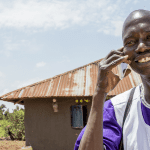Innovation for Adaptation: How a New Fund Is Helping Service Providers Navigate the Challenges of COVID-19
The impact of the ongoing pandemic has been felt greatly in all spheres, and the social sector is no exception. These challenges have been amplified at the local level in Kenya and Rwanda, where non-profit organizations offering services to vulnerable populations are finding it more difficult to provide beneficiaries with much-needed support. Born out of this need, Instiglio, with its partners, created the COVID-19 Adaptation Fund.
About three months have passed since the Adaptation Fund’s launch last October, when it provided funding to nine qualifying service providers. We’re now reflecting on our vision when setting up the fund, what we have learned to date about service delivery innovations that can support the poverty alleviation agenda, and the interesting insights we believe will continue to emerge as we collect and analyze progress data during the six months of the Fund’s implementation.
Our vision for the COVID-19 Adaptation fund
The vision behind the Adaptation Fund is to provide supporting funds to service providers that enable them to develop innovative, nimble and effective solutions to the challenges related to reaching beneficiaries and responding to their needs during the pandemic. In this challenge fund, service providers in Kenya and Rwanda competed to earn a portion of the total US $800,000 by proposing innovations that would allow them to better reach beneficiaries and generate long-term organizational adaptations to the crisis. This support is facilitating experimentation that can lead to innovative solutions that are likely to be effective, despite the constraints of COVID-19. The Adaptation Fund therefore offers an immediate answer to various needs arising during the pandemic, by providing flexible operational grants to help service providers create the needed space for adaptation.
We believe that the Adaptation Fund will play a key role in improving the livelihoods of at-risk populations, as well as testing innovative solutions geared towards building financial resilience and disaster preparedness. Insights from these solutions will also prove useful in informing governments and donors on policy and programming considerations, as different actors seek solutions to recapture lost momentum in the fight against extreme poverty.
Why we chose to focus on service providers
While most service providers have continued operations under the pandemic, albeit at a smaller scale, they’ve had limited financial bandwidth to dedicate resources to develop, test and deploy innovations aimed at addressing the challenges of the new operating context they are facing. Thus, the Adaptation Fund provided selected organizations with the financial support they needed to pursue innovations that have helped them continue to serve the most vulnerable. To that end, one criterion used to select service providers for funding was the potential of their proposed innovation to be replicated to other, similar contexts. Such potential, we hypothesize, may contribute to the sustainability of these innovations’ future impact and their success in alleviating poverty – along with their ability to be adopted by governments and other actors in this space.
The service providers selected for the Adaptation Fund
While most of the service providers who applied for the Adaptation Fund had promising innovations, we selected those whose innovations were most aligned with the Fund’s objectives, and those that exhibited the strongest capacity to implement their proposed innovations.
In Kenya, several service providers focused on business training facilitation through digital platforms. For instance, the African Entrepreneur Collective is an organization that supports refugee entrepreneurs’ efforts to improve their livelihoods by establishing and running small businesses: The Fund will support their innovation to deliver “resilience-focused” training with a curriculum focused on COVID-19-related business advice and “socially distant” financial support to businesses hard hit by the pandemic through online and mobile loans. Village Enterprise, an organization working in rural East Africa to serve extremely poor populations through poverty graduation programs, was selected for its innovation to develop digital programming solutions to replace or complement their current interventions. These solutions will include video programming for empowerment and technical training, a financial education mobile application, and phone-based training and mentoring. The Fund will also support Green Agri Ventures, an organization focused on improving the livelihoods of informal rural entrepreneurs by offering various business trainings: Their innovation will create a digital group lending application to help informal rural entrepreneurs adapt to the effects of COVID-19 through rapid business diagnostic services, virtual financial literacy training and increased linkages among entrepreneurs. We’ll also support the BOMA Project, an organization implementing poverty graduation programs for extremely poor populations in Kenya: The Fund will help them test and refine innovative technological solutions for adaptive in-person and remote mentorship programs to maintain service delivery during the pandemic.
Another category of innovations focused on the digitization of information, both to provide advisory services and to facilitate market linkages. For instance, Send a Cow Kenya is an organization that supports farmers and farm families/communities as they work to improve their livelihoods and achieve income and food security: Their innovation will test whether remote access to high-quality agricultural information enables beneficiaries to maintain pre-COVID-19 levels of food and income security. The Fund will also support Precision Agriculture for Development, an organization that delivers personalized agricultural advice to smallholder farmers through mobile phones. It will launch three new services within its SMS text platform: 1) a market information tool to connect farmers via information about farm input availability; 2) advisory information on how to maintain farm productivity with alternative soil management; and 3) a COVID-19 information tool to alert farmers when markets or other parts of the supply chain are disrupted.
In Rwanda, exciting innovations that were selected include initiatives to improve the availability of agricultural products through digital means, to adapt loan facilities and to provide digital cash. For instance, One Acre Fund, an organization that supports smallholder farmers with a bundle of products and services across the agricultural value chain, will launch an innovation to improve their nascent mobile-based enrollment platform and to train farmer group leaders to support other farmers in enrolling and ordering products through the platform. Tearfund, an organization that delivers livelihood support to vulnerable communities through self-help groups, cash transfers and voucher assistance, and economic empowerment, will use the Fund’s support to adapt their loan service in two ways: to provide capital to as many self-help groups as possible, and to incentivize both social protection grants for the most vulnerable and preparedness for future disasters by encouraging “saving for disaster” funds. We’ll also provide funding to Women for Women International, an organization that promotes the rights of marginalized women in war-affected countries, as they integrate a low-cost adaptation into their existing approach. Their innovation will provide conditional digital cash to women to mitigate the risks of those who become uninsured, and to help them avoid future health-related financial shocks.
What have we learned so far?
First of all, we’ve seen that challenges abound as the social sector adapts to the pandemic. Service providers currently face various obstacles, from the difficulty of engaging beneficiaries due to travel restrictions, to the challenge of fundraising. Furthermore, they are dealing with significant shortfalls in safety net coverage in Kenya and Rwanda. Although both countries have committed significant funding to support vulnerable populations (e.g. the Kenya COVID-19 Fund), they both face a difficult balancing act between boosting health capacities and improving livelihoods. And the limited resources available have mainly been directed towards health initiatives with vulnerable populations, leaving out other much-needed social protection services.
However, we’ve also seen that these challenges are spurring innovations. Most organizations are proactively finding ways to design innovative programs and sustain their implementation. Although local and international NGOs are experiencing operational and funding challenges, they continue to adapt their operations from “business as usual” to the new COVID-19 environment.
Consequently, there is a need for funding to support innovations. We saw this need directly after receiving more than 150 proposals for the Adaptation Fund from NGOs across Kenya and Rwanda. Due to the limited size and resources of the Fund, we were able to select only nine organizations. The innovations featured across the 150+ proposals were unique and diverse, falling mostly within four main sectors: agriculture, poverty graduation, trade and health. Proposed innovations also targeted vulnerable groups like marginalized women and refugee entrepreneurs – a unique population that has been heavily impacted by the pandemic – to sustainably assist them in rebuilding their lives.
Finally, we’ve seen that governments are also interested in innovative solutions: Their reception of the Adaptation Fund has been positive in both Kenya and Rwanda. In Kenya, we have engaged the Ministry of ICT’s COVID-19 ICT Advisory Committee, which is spearheading the implementation of innovative information and computer technology programs to tackle the effects of the pandemic. In Rwanda, we have worked with the Ministry of Finance and the Rwanda Governance Board to identify the government’s objectives and challenges that can help guide the focus of the Adaptation Fund. All the government agencies we’ve engaged have expressed an interest in finding effective ways to reach beneficiaries remotely, and exploring how to leverage ICT to keep services flowing. We continue to work with our government counterparts to develop the Adaptation Fund’s learning agenda, and we look forward to presenting lessons learned to our government partners once the program concludes.
What happens next?
Programs under the Adaptation Fund will be implemented for approximately six months, between October 2020 and April 2021, with a learning agenda conducted concurrently. The learning agenda has the objective of maximizing learning and drawing best practices and other insights from the Adaptation Fund implementation to inform other development sector efforts. The final learning agenda report is expected to be disseminated in May 2021.
The Adaptation Fund learning agenda will provide relevant insights for governments, donors, service providers and other stakeholders in the poverty alleviation and livelihoods sectors. Drawn from the specific experiences of the selected nine service providers and their innovations, it aims to identify those innovations that may be scaled and/or replicated to improve and adapt existing poverty alleviation programs and services. These insights will hopefully be effective in showing how organizations and programs can adapt to tackle the challenges brought by COVID-19 through efficient, cost-effective, flexible and easy-to-execute strategies. We expect these learnings to inform the wider development ecosystem and add to the growing body of innovative solutions emerging to solve these unprecedented challenges.
In conclusion, this fund promises to be an innovation catalyst that will improve livelihoods and continue to strengthen the economic capabilities of vulnerable and marginalized populations.
Michael Kiema is an Analyst and Linda Ndungu Wambua is a Manager at Instiglio.
Photo courtesy of Instiglio.
- Categories
- Coronavirus, Technology



